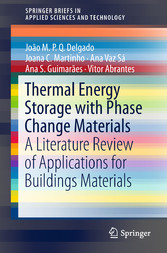Thermal Energy Storage with Phase Change Materials - A Literature Review of Applications for Buildings Materials
von: João M.P.Q. Delgado, Joana C. Martinho, Ana Vaz Sá, Ana S. Guimarães, Vitor Abrantes
Springer-Verlag, 2018
ISBN: 9783319974996
, 80 Seiten
Format: PDF, Online Lesen
Kopierschutz: Wasserzeichen
Preis: 53,49 EUR
eBook anfordern 
Mehr zum Inhalt

Thermal Energy Storage with Phase Change Materials - A Literature Review of Applications for Buildings Materials
This short book provides an update on various methods for incorporating phase changing materials (PCMs) into building structures. It discusses previous research into optimizing the integration of PCMs into surrounding walls (gypsum board and interior plaster products), trombe walls, ceramic floor tiles, concrete elements (walls and pavements), windows, concrete and brick masonry, underfloor heating, ceilings, thermal insulation and furniture an indoor appliances.
Based on the phase change state, PCMs fall into three groups: solid-solid PCMs, solid-liquid PCMs and liquid-gas PCMs. Of these the solid-liquid PCMs, which include organic PCMs, inorganic PCMs and eutectics, are suitable for thermal energy storage.
The process of selecting an appropriate PCM is extremely complex, but crucial for thermal energy storage. The potential PCM should have a suitable melting temperature, and the desirable heat of fusion and thermal conductivity specified by the practical application. Thus, the methods of measuring the thermal properties of PCMs are key.
With suitable PCMs and the correct incorporation method, latent heat thermal energy storage (LHTES) can be economically efficient for heating and cooling buildings. However, several problems need to be tackled before LHTES can reliably and practically be applied.










